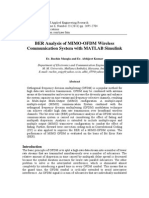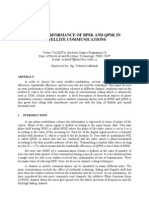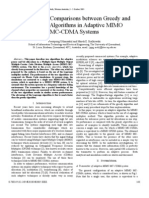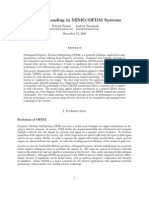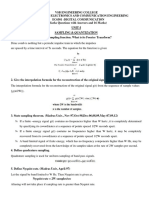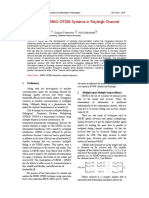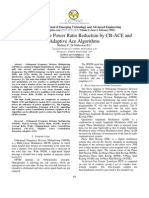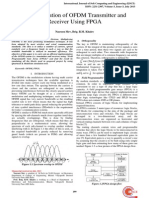Optimal Modulation and Coding For Spatial Multiplexing Under Flat Fading Channel
Optimal Modulation and Coding For Spatial Multiplexing Under Flat Fading Channel
Copyright:
Available Formats
Optimal Modulation and Coding For Spatial Multiplexing Under Flat Fading Channel
Optimal Modulation and Coding For Spatial Multiplexing Under Flat Fading Channel
Original Title
Copyright
Available Formats
Share this document
Did you find this document useful?
Is this content inappropriate?
Copyright:
Available Formats
Optimal Modulation and Coding For Spatial Multiplexing Under Flat Fading Channel
Optimal Modulation and Coding For Spatial Multiplexing Under Flat Fading Channel
Copyright:
Available Formats
IOSR Journal of Engineering (IOSRJEN)
e-ISSN: 2250-3021, p-ISSN: 2278-8719
Vol. 3, Issue 6(June. 2013), ||V1 || PP 22-25
www.iosrjen.org 22 | P a g e
Optimal modulation and coding for spatial multiplexing under
flat fading channel.
Monika Jain, Student, M.Tech. (ECE) (B.M.I.E.T. Sonipat), Sandeep Singh and Megha
Gupta, (B.M.I.E.T. Sonipat)
Abstract:- In spatial multiplexing i.e., multiple-input multiple-output (MIMO-OFDM) system, coding schemes
can be employed in link adaptation algorithms to improve data rates, effective use of allocated frequency
spectrum and further to mitigate the effect of dynamic nature of the channel are used. Coding schemes can be
used in link adaptation algorithms [1]. These loading algorithms adapt the system parameters according to the
channel state information (CSI). It also improves the bit error rate (BER) performance and minimizes the total
power input at the transmitter while maintaining a defined data-rate constraint. Ultimately, these algorithms
gives better performance in the flat fading channel which will also be confirmed by simulation results.
Keywords:- BER, Gray code, MISO, M-PSK, SISO, SNR, TCM
I. INTRODUCTION
The permeating use of wireless communication is fueling the need for higher data rates and channel
capacity. OFDM technology is capable of solving the difficult inter-symbol interference problem encountered
with high data rates across multiple channels. The multi-carrier technology in form of MIMO-OFDM is widely
organized as one of the most promising access scheme for the wireless network over SISO-OFDM without
wasting spectrum source. By dividing the bandwidth into the small frequency bands, the data can be transmitted
across multiple narrowband channels but it suffer only from flat fading [6]. The orthogonality of the sub-carriers
in OFDM makes it possible to use different modulation schemes for different subcarriers.
A way to combat with flat fading is to adapt number of bits and power level on each sub-carrier
according to CSI [2]. Here if, using adaptive modulation and MIMO-OFDM with appropriate coding schemes to
create an effective algorithm can result in efficient BER performance for broadband wireless MIMO-OFDM
system. The objective of using link adaptation scheme is to get best possible system performance based on CSI.
The paper is organized as follows:-Section 2 introduce system model, section 3 is about adaptive modulation
and Section 4 introduce link adaptation criterion. Finally, the simulation results and a conclusion is presented in
section 5 and 6.
II. SYSTEM MODEL
In a MIMO-OFDM system with N subcarriers (or tones) the individual data streams are first passed
through OFDM modulators which perform an IFFT on blocks of length N followed by a parallel-to-serial
conversion. A cyclic prefix (CP) containing a copy of the last samples of the parallel-to-serial converted output
of the N-point IFFT is then prepended. The resulting OFDM symbols are launched simultaneously from the
individual transmit antennas. The CP is essentially a guard interval which serves to eliminate interference
between OFDM symbols and turns linear convolution into circular convolution such that the channel is
diagonalized by the FFT. In the receiver the individual signals are passed through OFDM demodulators which
first discard the CP and then perform an N-point FFT. The outputs of the OFDM demodulators are finally
separated and decoded. The assumption of the length of the CP being greater or equal than the length of the
discrete-time base-band channel impulse response guarantees that the MIMO fading channel indeed decouples
into a set of parallel MIMO fading channels [5].
Fig. 1 System Model block diagram
Optimal modulation and coding for spatial multiplexing
www.iosrjen.org 23 | P a g e
III. ADAPTIVE MODULATION
Adaptive modulation in OFDM is a technique of using different modulation modes in different sub-
carriers depending on the instantaneous signal to noise (SNR) ratio for each sub-channel. Channel conditions are
estimated at the receiver and CSI is sent to the transmitter to adapt the transmission accordingly. Parameters like
transmitted power required, numbers of bits on each sub-carrier modulation scheme or combination of these can
be adapted according to the channel condition. Nearly, all communication system requires some target BER not
to be exceeded. It is possible to assume an average BER or an instantaneous BER as a constraint. Another
assumption that can be made is the knowledge of CSI for each sub-carrier. When no adaption is done, the
system present low SNR. To maintain the targeted BER, it is necessary to compensate the state of channel by
adapting the transmitted power level.
The nature of OFDM allows the signal to modulate in amplitude and phase. In this paper we will obtain
our result from phase shift keying modulation (M-PSK), where the amplitude of the transmitted signal is
constrained to remain constant, thereby yielding a circular constellation. By allowing the amplitude to vary with
phase another modulation scheme called quadrature amplitude modulation (QAM) can also be obtained.
IV. LINK ADAPTATION CRITERION
Loading algorithms in multicarrier systems computes number of bits
n
b
and power
n
c
required for
transmitting these allocated bits on each sub-channel. There are two types of loading algorithms i.e., those
which try to maximize data rate while maintaining a target BER constraint and others which try to maximize
performance at a given fixed data rate.
In this paper, two algorithms are used for adaptive bit and power loading i.e., Chows algorithm and
Compellos algorithm. Initially each sub-channel was allocated energy using Chows algorithm and at the same
time it was allocated maximum number of bits allowable per sub-channel. Then bit allocation was done using
Compellos algorithm.
IV.1. Chows Algorithm:- Chow was able to verify that an on/off energy distribution, as long as it used
the same or nearly the same transmission band as water-filling, exhibits negligible loss with respect to the exact
water-filling shape[4].The procedure is summarized as follows:
a).Compute the sub-channel signal to noise ratios based on the formula
2
( )
( )
( )
Subcarriers gain
SNR i
noise gap
=
Where ( ) SNR i is the signal to noise ratio for ratio for each sub-
channel.
b).Compute the number of bits for the
th
i sub-channel based on the formula:
( ) 2
( )
( ) log 1
SNR i
b i = +
I
Here
( ) b i
is the number of allocated on each subcarriers
c).Round the value
( ) b i
down to integer
( ) b i
d).Restrict
( ) b i
to take values 0, 1, 2, 4, 6 or 8.
e).Compute the energy for the
th
i
subcarrier based on the number of bits initially assigned to it using the
formula:
( )
(2 1)
( ( ))
( )
b i
i
e b i
GNR i
=
Where ( ) GNR i is
( ) SNR i
gap
The gap works as tuning parameter, different values of gap gives different
0
/
b
E N ratio for given desired
number of bits to be transmitted.
IV.2. Compello Algorithm: - The Compellos algorithm is nothing but a one bit B-tightness algorithm [3].
Given the initial bit allocation, the B-tightness simply states the correct number of bits is being transmitted and
optimized the bit allocation.
A
|
-tightening (
|
T) algorithm is:
Optimal modulation and coding for spatial multiplexing
www.iosrjen.org 24 | P a g e
a).Set
1
N
n
n
b b
=
=
b).While
b b =
If
b b >
(1)
| | { }
1
arg max (
n N n n
n e b |
s s
+
(2)
b b |
(3)
n n
b b |
Else
(1)
| | { }
1
arg min (
n N n n
m e b |
s s
+
(2)
b b | +
(3)
n n
b b | = +
Channel index
(a) Channel Frequency Response
For instance, these two algorithms can be configured in following figures. This figure 2 illustrates the
typical channel frequency response, the discrete bit allocation to each tone, and the corresponding energy on
each tone.
Channel index
(b)Discrete energy allocation
Channel index
(c)Discrete allocation bit
Fig. 2. Optimal bit and power allocation (a) Channel frequency response (b) Energy Allocation
(c) Discrete Bit Allocation
V. SIMULATION AND RESULTS
In this section simulation result for adaptive M-PSK, adaptive M-PSK with gray coding and adaptive
M-PSK with TCM under flat fading Rayleigh channel is presented. Functioning of the channel without any
Optimal modulation and coding for spatial multiplexing
www.iosrjen.org 25 | P a g e
delay is necessary and assumed during the simulation at the transmitter and the receiver for the implementation
of the link adaptation algorithms. The entire system is considered as discrete time system.
Figure 3 and 4 shows the graphical representation of BER vs Eb/No performance under flat fading channel
(Rayleigh channel) for SISO-OFDM and MIMO-OFDM(2X2 antenna).
The system with 64 subcarriers, 64 OFDM symbol time periods, and 16 symbol periods for guard time.
The parameters were held constant throughout the simulation. M-PSK adaptive modulation for each subcarrier
is used whereas 2 PSK, 4PSK, 16PSK, 64PSK AND 256PSK the usable modulation modes configurations.
Fig.3. BER vs Eb/No values for adaptive MPSK, adaptive MPSK with Gray coding and adaptive MPSK
with TCM SISO-OFDM system under flat fading channel.
Fig.4. BER vs Eb/No graph for Adaptive MPSK . adaptive MPSK with gray coding and adaptive MPSK
with TCM for MIMO-OFDM system under flat fading channel.
VI. CONCLUSION
Link adaptation algorithms with TCM and Gray code results in improvement of BER performance for
MIMO-OFDM system over SISO-OFDM system with M-PSK. The simulation result indicates that coded
adaptive OFDM systems are better as compared to non coded adaptive OFDM systems.
REFERENCES
[1]. Guoting Lai Junxun Yin Fan Lin Huawen Yu, Performance of Adaptive Bit and Power Allocation
MIMO-OFDM System Based on Greedy Algorithm, IEEE Wireless Communication and Networking
Conference, vol. 1 , 2005 pp, 44-49.
[2]. Liu Jiancai Yang Wanwan Zheng Weili Wang Yafu Ye Zhihui Xu Jiakai and Ning Xinbao Adaptive bit
and power loading algorithm with low complexity in MIMO-OFDM systems, IEEE international
conference, 2009,
[3]. J. Campello: Optimal discrete bit loading for multicarrier modulation systems, Proc. of the IEEE Int.
Symp. On Information Theory, p. 193, Cambrige, MA, USA, Aug. 1998.
[4]. Yu Qing and Wang Yi Improved Chow Algorithm Used in Adaptive OFDM system DOI 10.1109/
CMC .2010.2122010 IEEE.
[5]. H. Bolcskei and A. J. Paulraj, Space-frequency coded broadband OFDM systems," in Proc.IEEE
WCNC-2000, Chicago, IL, Sept. 2000, pp. 1-6.
[6]. Hung Tuan Ngugen, Jogen Bach Andersen and Gert Frolund Prdersen, On the Performance of Link
Adaptation Techniques in MIMO systems, Wireless Personal Communications, Springer Publications,
2006
You might also like
- EE256!! - Sheet 7 - Spring2023Document3 pagesEE256!! - Sheet 7 - Spring2023Osama Mohamed Mohamed ShabanaNo ratings yet
- Lo Cockpit Extraction in SAP BWDocument5 pagesLo Cockpit Extraction in SAP BWshivdeepbNo ratings yet
- Skylock Product Description 2013 PDFDocument25 pagesSkylock Product Description 2013 PDFCekidot GanNo ratings yet
- A Comparative Performance Analysis of OFDM Using MATLAB Simulation With M-PSK and M-QAM MappingDocument5 pagesA Comparative Performance Analysis of OFDM Using MATLAB Simulation With M-PSK and M-QAM MappingShilpa SharmaNo ratings yet
- IJCER (WWW - Ijceronline.com) International Journal of Computational Engineering ResearchDocument6 pagesIJCER (WWW - Ijceronline.com) International Journal of Computational Engineering ResearchInternational Journal of computational Engineering research (IJCER)No ratings yet
- The LabVIEW Simulation of Space-Time Coding Technique in The MIMO-OfDM SystemDocument6 pagesThe LabVIEW Simulation of Space-Time Coding Technique in The MIMO-OfDM Systemivy_publisherNo ratings yet
- An Efficient LMMSE Estimator For MIMOOFDM Systems Over Flat Fading ChannelDocument4 pagesAn Efficient LMMSE Estimator For MIMOOFDM Systems Over Flat Fading ChannelseventhsensegroupNo ratings yet
- To Improve Performance of OFDM System Using Optimize Adaptive Coding Technique With Convolutional and BCH CodingDocument7 pagesTo Improve Performance of OFDM System Using Optimize Adaptive Coding Technique With Convolutional and BCH CodingInternational Journal of Application or Innovation in Engineering & ManagementNo ratings yet
- Pub-Et 13762Document13 pagesPub-Et 13762Adinadh KrNo ratings yet
- BER Analysis of MIMO-OFDMDocument10 pagesBER Analysis of MIMO-OFDMAbhijeet KumarNo ratings yet
- Error Performance of BPSK and QPSK in Satellite CommunicationsDocument3 pagesError Performance of BPSK and QPSK in Satellite CommunicationsBajrang ChoudharyNo ratings yet
- 10.1007 - s11760 007 0017 4Document14 pages10.1007 - s11760 007 0017 4Babu MerigalaNo ratings yet
- Performance Comparisons Between Greedy and Lagrange Algorithms in Adaptive MIMO MC-CDMA SystemsDocument5 pagesPerformance Comparisons Between Greedy and Lagrange Algorithms in Adaptive MIMO MC-CDMA SystemsFirman Nico ChandraNo ratings yet
- projetDocument5 pagesprojetromijaj238No ratings yet
- Ofdm Articl SimulDocument8 pagesOfdm Articl SimulazerNo ratings yet
- Project Report 359Document12 pagesProject Report 359Sayeed Habeeb100% (1)
- Unit-3 Diversity Techniques: (1) Repetition Coding and Time DiversityDocument14 pagesUnit-3 Diversity Techniques: (1) Repetition Coding and Time DiversityRakesh DevallaNo ratings yet
- Structure of The DemoDocument9 pagesStructure of The DemoSrinivas HeroNo ratings yet
- Improving MIMO Spectral Efficiency in 4G Macro-Cellular NetworksDocument6 pagesImproving MIMO Spectral Efficiency in 4G Macro-Cellular Networksወንድሙ ዘገዬNo ratings yet
- VLC Communication B-10Document10 pagesVLC Communication B-10Pavan KumarNo ratings yet
- Multiuser MIMO Downlink Transmission With BEM-based Limited Feedback Over Doubly Selective ChannelsDocument13 pagesMultiuser MIMO Downlink Transmission With BEM-based Limited Feedback Over Doubly Selective ChannelsNguyen JustinNo ratings yet
- Iii Part A BDocument115 pagesIii Part A BDivya SreeNo ratings yet
- Error Probability of Different Modulation Schemes For OFDM Based WLAN Standard IEEE 802.11aDocument6 pagesError Probability of Different Modulation Schemes For OFDM Based WLAN Standard IEEE 802.11aaboashoorNo ratings yet
- Performance Analysis of OFDM For Different Modulation TechniquesDocument6 pagesPerformance Analysis of OFDM For Different Modulation Techniquesrahman08413No ratings yet
- DC Lab Manual Simulation ExperimentsDocument29 pagesDC Lab Manual Simulation Experimentsrobinmyow211No ratings yet
- BER of OFDM System Using Concatenated Forward Error Correcting Codes (FEC) Over Nakagami-M Fading ChannelDocument5 pagesBER of OFDM System Using Concatenated Forward Error Correcting Codes (FEC) Over Nakagami-M Fading Channelseventhsensegroup100% (1)
- Sidelobe Suppression and PaprDocument8 pagesSidelobe Suppression and PaprMandy DiazNo ratings yet
- A Flexible OFDM System Simulation Model With BER Performance TestDocument10 pagesA Flexible OFDM System Simulation Model With BER Performance Testnamhoa02No ratings yet
- OFDM Versus Single Carrier With Cyclic Prefix: A System-Based Comparison For Binary ModulationDocument4 pagesOFDM Versus Single Carrier With Cyclic Prefix: A System-Based Comparison For Binary ModulationKieu HuongNo ratings yet
- Performance Analysis by Improving Bit Error Rate (BER) Through Various Diversity Techniques in Wireless CommunicationDocument5 pagesPerformance Analysis by Improving Bit Error Rate (BER) Through Various Diversity Techniques in Wireless CommunicationAdugna BefekaduNo ratings yet
- MimoDocument3 pagesMimoJo DarlingNo ratings yet
- 2005 Interpolation Based Transmit BeamformingDocument11 pages2005 Interpolation Based Transmit BeamformingweromNo ratings yet
- On Opportunistic Power Control For MIMO-OFDM Systems: Norbert Reider G Abor FodorDocument6 pagesOn Opportunistic Power Control For MIMO-OFDM Systems: Norbert Reider G Abor FodorMujeeb AbdullahNo ratings yet
- Equalized GMSK, Equalized QPSK and OFDM, A Comparative Study For High-Speed Wireless Indoor Data CommunicationsDocument5 pagesEqualized GMSK, Equalized QPSK and OFDM, A Comparative Study For High-Speed Wireless Indoor Data CommunicationsAhmed MidoNo ratings yet
- An Experimental OFDM-Modem For The CENELEC B-BandDocument8 pagesAn Experimental OFDM-Modem For The CENELEC B-Bandu235861No ratings yet
- Soft Output DemapperDocument5 pagesSoft Output DemapperSomendra SahuNo ratings yet
- Tas With Qam-M (M 2, 3, 4, 5, 6) For Mimo Communication SystemDocument4 pagesTas With Qam-M (M 2, 3, 4, 5, 6) For Mimo Communication SystemesatjournalsNo ratings yet
- Performance of MIMO-OFDM Systems in Rayleigh Channel: Eni Dwi Wardihani, Subuh Pramono, Nia WatoniahDocument6 pagesPerformance of MIMO-OFDM Systems in Rayleigh Channel: Eni Dwi Wardihani, Subuh Pramono, Nia Watoniahtyas ayuNo ratings yet
- Mc-Cdma:: Turbo CodesDocument3 pagesMc-Cdma:: Turbo CodesRaja Abdul MuneebNo ratings yet
- SINR and Throughput Analysis For Random Beamforming Systems With Adaptive ModulationDocument12 pagesSINR and Throughput Analysis For Random Beamforming Systems With Adaptive ModulationThuy Dung NguyenNo ratings yet
- Performance Analysis of MIMO-OFDM Systems On Nakagami-M Fading ChannelsDocument5 pagesPerformance Analysis of MIMO-OFDM Systems On Nakagami-M Fading ChannelsmnoppNo ratings yet
- A Carrier Interferometry Based Channel Estimation Technique For Mimo-OfdmDocument12 pagesA Carrier Interferometry Based Channel Estimation Technique For Mimo-OfdmLarry WagnerNo ratings yet
- Novel WeigtedDocument5 pagesNovel WeigtedLiju TrNo ratings yet
- Peak-To-Average Power Ratio Reduction by CB-ACE and Adaptive Ace AlgorithmsDocument8 pagesPeak-To-Average Power Ratio Reduction by CB-ACE and Adaptive Ace AlgorithmsShankar GaneshNo ratings yet
- MIMO ChannelDocument5 pagesMIMO ChannelDaniel CadenaNo ratings yet
- Performance Analysis of MIMO-OFDM System Using QOSTBC Code Structure For M-QAMDocument12 pagesPerformance Analysis of MIMO-OFDM System Using QOSTBC Code Structure For M-QAMNoha HassanNo ratings yet
- Comparison of Three Different Cancellation Schemes For Orthogonal Frequency Division Multiplexing OFDM SystemDocument3 pagesComparison of Three Different Cancellation Schemes For Orthogonal Frequency Division Multiplexing OFDM SystemEditor IJTSRDNo ratings yet
- Implementation of OFDM Transmitter and Receiver Using FPGA: Nasreen Mev, Brig. R.M. KhaireDocument4 pagesImplementation of OFDM Transmitter and Receiver Using FPGA: Nasreen Mev, Brig. R.M. Khaireankita6298No ratings yet
- Throughput and Error State Performance of AMC Scheme in 3G Wireless SystemsDocument4 pagesThroughput and Error State Performance of AMC Scheme in 3G Wireless SystemsInternational Organization of Scientific Research (IOSR)No ratings yet
- Bit Error Rate Evaluation of IEEE 802.16 in OFDM SystemDocument4 pagesBit Error Rate Evaluation of IEEE 802.16 in OFDM Systemabhi_rules08No ratings yet
- GMSK Demodulator Using Costas Loop For Software-Defined RadioDocument5 pagesGMSK Demodulator Using Costas Loop For Software-Defined RadioRanjith ReddyNo ratings yet
- Impact of Nonlinear Power Amplifiers On The Performance of Precoded MIMO Satellite SystemsDocument7 pagesImpact of Nonlinear Power Amplifiers On The Performance of Precoded MIMO Satellite Systemsntnam113No ratings yet
- Digital Modulation I August09Document14 pagesDigital Modulation I August09gzb012No ratings yet
- Flowchart Bitloading OfdmDocument4 pagesFlowchart Bitloading Ofdmdeepa2400No ratings yet
- Transmitter Architecture For Pulsed Ofdm: Kai-Chuan Chang, Gerald E. Sobelman, Ebrahim Saberinia and Ahmed H. TewfikDocument4 pagesTransmitter Architecture For Pulsed Ofdm: Kai-Chuan Chang, Gerald E. Sobelman, Ebrahim Saberinia and Ahmed H. TewfikPramanshu SinghNo ratings yet
- Final: Total 200 Points, Duration: 12:15pm-3:15pm: EE 359 - Wireless Communications - Autumn 2016Document3 pagesFinal: Total 200 Points, Duration: 12:15pm-3:15pm: EE 359 - Wireless Communications - Autumn 2016Debajyoti DattaNo ratings yet
- 1 PB PDFDocument9 pages1 PB PDFMokone Pro MokoneNo ratings yet
- A Simple Adaptive Beamforming Algorithm With Interference SuppressionDocument4 pagesA Simple Adaptive Beamforming Algorithm With Interference SuppressionSiva Sagar GurujulaNo ratings yet
- Advanced Multicarrier Technologies for Future Radio Communication: 5G and BeyondFrom EverandAdvanced Multicarrier Technologies for Future Radio Communication: 5G and BeyondNo ratings yet
- Application of The Multi-Curve Reconstruction Technology in Seismic InversionDocument4 pagesApplication of The Multi-Curve Reconstruction Technology in Seismic InversionIOSRJEN : hard copy, certificates, Call for Papers 2013, publishing of journalNo ratings yet
- Random Fixed Point Theoremsin Metric Space: Balaji R Wadkar, Ramakant Bhardwaj, Basantkumar SinghDocument9 pagesRandom Fixed Point Theoremsin Metric Space: Balaji R Wadkar, Ramakant Bhardwaj, Basantkumar SinghIOSRJEN : hard copy, certificates, Call for Papers 2013, publishing of journalNo ratings yet
- The Experimental Study On The Compatibility Relationship of Polymer and Oil LayerDocument5 pagesThe Experimental Study On The Compatibility Relationship of Polymer and Oil LayerIOSRJEN : hard copy, certificates, Call for Papers 2013, publishing of journalNo ratings yet
- MMSE Adaptive Receiver vs. Rake Receiver Performance Evaluation For UWB Signals Over Multipath Fading ChannelDocument13 pagesMMSE Adaptive Receiver vs. Rake Receiver Performance Evaluation For UWB Signals Over Multipath Fading ChannelIOSRJEN : hard copy, certificates, Call for Papers 2013, publishing of journalNo ratings yet
- Construction of Self-Regulated EFL Micro-Course Learning: Zhongwen LiuDocument4 pagesConstruction of Self-Regulated EFL Micro-Course Learning: Zhongwen LiuIOSRJEN : hard copy, certificates, Call for Papers 2013, publishing of journalNo ratings yet
- Study On Logging Interpretation Model and Its Application For Gaotaizi Reservoir of L OilfieldDocument6 pagesStudy On Logging Interpretation Model and Its Application For Gaotaizi Reservoir of L OilfieldIOSRJEN : hard copy, certificates, Call for Papers 2013, publishing of journalNo ratings yet
- The Identification of Lithologic Traps in Nanpu Sag D3 Member of Gaonan RegionDocument5 pagesThe Identification of Lithologic Traps in Nanpu Sag D3 Member of Gaonan RegionIOSRJEN : hard copy, certificates, Call for Papers 2013, publishing of journalNo ratings yet
- "Sign Language Translator": Mr. Sangam Mhatre, Mrs. Siuli DasDocument4 pages"Sign Language Translator": Mr. Sangam Mhatre, Mrs. Siuli DasIOSRJEN : hard copy, certificates, Call for Papers 2013, publishing of journalNo ratings yet
- Strength Properties of Commercially Produced Clay Bricks in Six Different Locations/ States in NigeriaDocument10 pagesStrength Properties of Commercially Produced Clay Bricks in Six Different Locations/ States in NigeriaIOSRJEN : hard copy, certificates, Call for Papers 2013, publishing of journalNo ratings yet
- Effectiveness in Addressing The Sustainability and Environmental Issue Involving Use of Coal Ash As Partial Replacement of Cement in ConcreteDocument6 pagesEffectiveness in Addressing The Sustainability and Environmental Issue Involving Use of Coal Ash As Partial Replacement of Cement in ConcreteIOSRJEN : hard copy, certificates, Call for Papers 2013, publishing of journalNo ratings yet
- Introduction To Accounting Professional Judgment ManipulationDocument3 pagesIntroduction To Accounting Professional Judgment ManipulationIOSRJEN : hard copy, certificates, Call for Papers 2013, publishing of journalNo ratings yet
- Constructions Quality Versus Bad Components in Jordanian CementDocument3 pagesConstructions Quality Versus Bad Components in Jordanian CementIOSRJEN : hard copy, certificates, Call for Papers 2013, publishing of journalNo ratings yet
- Validating The Theories of Urban Crime in The City of RaipurDocument10 pagesValidating The Theories of Urban Crime in The City of RaipurIOSRJEN : hard copy, certificates, Call for Papers 2013, publishing of journalNo ratings yet
- Modeling and Design of Hybrid Power Plants: Ahmed KH A. E. AlkhezimDocument5 pagesModeling and Design of Hybrid Power Plants: Ahmed KH A. E. AlkhezimIOSRJEN : hard copy, certificates, Call for Papers 2013, publishing of journalNo ratings yet
- I 05815457Document4 pagesI 05815457IOSRJEN : hard copy, certificates, Call for Papers 2013, publishing of journalNo ratings yet
- The Research of Source System On Chang 6 Sand Formation in Ansai OilfieldDocument5 pagesThe Research of Source System On Chang 6 Sand Formation in Ansai OilfieldIOSRJEN : hard copy, certificates, Call for Papers 2013, publishing of journalNo ratings yet
- Detecting Spammers in Youtube: A Study To Find Spam Content in A Video PlatformDocument5 pagesDetecting Spammers in Youtube: A Study To Find Spam Content in A Video PlatformIOSRJEN : hard copy, certificates, Call for Papers 2013, publishing of journalNo ratings yet
- Assessment of The Life Quality of Urban Areas Residents (The Case Study of The City of Fahraj)Document6 pagesAssessment of The Life Quality of Urban Areas Residents (The Case Study of The City of Fahraj)IOSRJEN : hard copy, certificates, Call for Papers 2013, publishing of journalNo ratings yet
- Application of Cloud Transformation Technology in Predicting Reservoir PropertyDocument4 pagesApplication of Cloud Transformation Technology in Predicting Reservoir PropertyIOSRJEN : hard copy, certificates, Call for Papers 2013, publishing of journalNo ratings yet
- Oil and Water Layer Identification by Dual-Frequency Resistivity LoggingDocument4 pagesOil and Water Layer Identification by Dual-Frequency Resistivity LoggingIOSRJEN : hard copy, certificates, Call for Papers 2013, publishing of journalNo ratings yet
- Yingtai Area in Songliao Basin As The Main Layer Tight Oil "Dessert" Reservoir PredictionDocument4 pagesYingtai Area in Songliao Basin As The Main Layer Tight Oil "Dessert" Reservoir PredictionIOSRJEN : hard copy, certificates, Call for Papers 2013, publishing of journalNo ratings yet
- Bose-Einstein Condensation Controlled by (HOP+OLP) Trapping PotentialsDocument5 pagesBose-Einstein Condensation Controlled by (HOP+OLP) Trapping PotentialsIOSRJEN : hard copy, certificates, Call for Papers 2013, publishing of journalNo ratings yet
- Genetic Analysis of Low Resistivity Reservoir: Gang Wang, Kai Shao, Yuxi CuiDocument3 pagesGenetic Analysis of Low Resistivity Reservoir: Gang Wang, Kai Shao, Yuxi CuiIOSRJEN : hard copy, certificates, Call for Papers 2013, publishing of journalNo ratings yet
- Analysis of Distribution and Effection of Oil-Water: Yue FeiDocument6 pagesAnalysis of Distribution and Effection of Oil-Water: Yue FeiIOSRJEN : hard copy, certificates, Call for Papers 2013, publishing of journalNo ratings yet
- Classification of Fault Condensed Belt and Faults Development Characteristics in Xingbei Region, Daqing PlacanticlineDocument5 pagesClassification of Fault Condensed Belt and Faults Development Characteristics in Xingbei Region, Daqing PlacanticlineIOSRJEN : hard copy, certificates, Call for Papers 2013, publishing of journalNo ratings yet
- Characteristic of Cracks in Tight Sandstone Reservoir: Ming Yan Yunfeng Zhang Jie Gao Ji GaoDocument4 pagesCharacteristic of Cracks in Tight Sandstone Reservoir: Ming Yan Yunfeng Zhang Jie Gao Ji GaoIOSRJEN : hard copy, certificates, Call for Papers 2013, publishing of journalNo ratings yet
- Symbolism As A Modernist Featurein A Passage To India: Ahmad Jasim Mohammad, Suhairsaad Al-DeenDocument4 pagesSymbolism As A Modernist Featurein A Passage To India: Ahmad Jasim Mohammad, Suhairsaad Al-DeenIOSRJEN : hard copy, certificates, Call for Papers 2013, publishing of journalNo ratings yet
- Control Unit:: Hardwired vs. Microprogrammed ApproachDocument49 pagesControl Unit:: Hardwired vs. Microprogrammed ApproachskskaundilyaNo ratings yet
- Configuring Teradata Vantage™ After InstallationDocument57 pagesConfiguring Teradata Vantage™ After InstallationaureltataruNo ratings yet
- TELEBOT Complete Home AutomationDocument33 pagesTELEBOT Complete Home AutomationGS RathoreNo ratings yet
- Assignment For Bmn-301Document7 pagesAssignment For Bmn-301Sandip MukherjeeNo ratings yet
- Present Perfect in EnglishDocument9 pagesPresent Perfect in EnglishIulian StănescuNo ratings yet
- Programming With STM32: Getting Started With The Nucleo Board and C/C++ Donald Norris 2024 Scribd DownloadDocument54 pagesProgramming With STM32: Getting Started With The Nucleo Board and C/C++ Donald Norris 2024 Scribd Downloadlusianimlahi100% (5)
- IT Essentials-Cisco Exam PaperDocument135 pagesIT Essentials-Cisco Exam PaperManish JangidNo ratings yet
- MidtermPracticeQuestions SolutionsDocument6 pagesMidtermPracticeQuestions SolutionsANIL EREN GÖÇERNo ratings yet
- Get Test Bank for Starting out with Visual C# 2012, 3/E 3rd Edition : 0133129454 PDF ebook with Full Chapters NowDocument15 pagesGet Test Bank for Starting out with Visual C# 2012, 3/E 3rd Edition : 0133129454 PDF ebook with Full Chapters Nowprikoguisse100% (17)
- Distributed Computing PPTDocument37 pagesDistributed Computing PPTSakthivelNo ratings yet
- Chapter 2 Part 3Document53 pagesChapter 2 Part 3Yoomif TubeNo ratings yet
- 5.2b Lecture SlidesDocument49 pages5.2b Lecture SlidesSumayyah ArslanNo ratings yet
- Choosing Gear For Your Smaart Measurement SystemDocument17 pagesChoosing Gear For Your Smaart Measurement SystemTheerayoot PoomchaiNo ratings yet
- Fabrice ResumeDocument2 pagesFabrice Resumeapi-341965921No ratings yet
- Activity 1. 1: Css Course: Exploratory Conduct Testing and Documentation #1Document4 pagesActivity 1. 1: Css Course: Exploratory Conduct Testing and Documentation #1abner venusNo ratings yet
- Media and Information Literacy - Q3 - Week 1Document7 pagesMedia and Information Literacy - Q3 - Week 1Angelo Martinez75% (4)
- Pharma 4.0 - Digitalisasi Industri Farmasi - Iai - 11 April 2021Document40 pagesPharma 4.0 - Digitalisasi Industri Farmasi - Iai - 11 April 2021lisaNo ratings yet
- Ficha Hanyoung KXN SeriesDocument3 pagesFicha Hanyoung KXN SeriesJorge Martin Bejarano Gonzalez0% (1)
- 9 GHZ To 12 GHZ, Gaas, Mmic, I/Q Downconverter: Hmc908ADocument26 pages9 GHZ To 12 GHZ, Gaas, Mmic, I/Q Downconverter: Hmc908AYumnaNo ratings yet
- DSAP-Lecture 5 - Array Based SequencesDocument45 pagesDSAP-Lecture 5 - Array Based SequencesAnnisa NurfadilahNo ratings yet
- Advanced Java Cha 1Document52 pagesAdvanced Java Cha 1Dawit WoldemichaelNo ratings yet
- Ap Gramasachivalayam Village - Revenue - Officer - (GR - II)Document26 pagesAp Gramasachivalayam Village - Revenue - Officer - (GR - II)ashNo ratings yet
- COMPUTER LITERACY BASICS: A COMPREHENSIVE GUIDE TO IC3 5 TH EDITION BY: MORRISON, C., WELLS, D. AND RUFOLLO, Chapter 1Document43 pagesCOMPUTER LITERACY BASICS: A COMPREHENSIVE GUIDE TO IC3 5 TH EDITION BY: MORRISON, C., WELLS, D. AND RUFOLLO, Chapter 1Crys CortezNo ratings yet
- Methodology To Perform Rail Analysis at A Very Early Stage of The Design Using Astro-RailDocument14 pagesMethodology To Perform Rail Analysis at A Very Early Stage of The Design Using Astro-RailBharath MnNo ratings yet
- Fortigate System Admin 40 Mr3Document331 pagesFortigate System Admin 40 Mr3ROMAN FORTISNo ratings yet
- 3BTG811796-3024 Functional Description - PP - UMCLibDocument17 pages3BTG811796-3024 Functional Description - PP - UMCLibJosé M. Torres B.No ratings yet
- UntitledDocument22 pagesUntitledHappyNo ratings yet
- Heizer Om14 Im 03Document28 pagesHeizer Om14 Im 03Kanishka KartikeyaNo ratings yet









